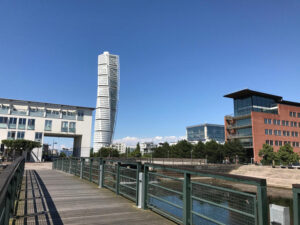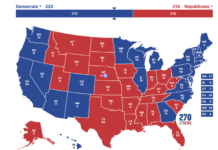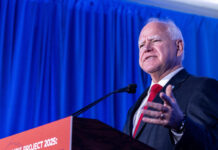APRIL 22, 2023

The “Turning Torso” tower in Malmö, Sweden. The nation’s third largest city, it has a population of 600,000 and is working to be carbon-neutral by 2030. The city is building new eco-neighborhoods that combine urban planning and energy-efficient buildings in areas that are walkable, bikable and inviting. The Western Harbor neighborhood, pictured, includes many public spaces, ponds and green roofs. Many of the buildings are heated by a heat pump installation that stores water in natural underground reservoirs to warm buildings. The water is heated using solar collectors on the buildings. In the summer, buildings are cooled by cooling air using seawater. – Elizabeth Weise
Climate news can seem dire with little hope for a better world. Talk to climate scientists, engineers and researchers, however, and they see a different future – a positive one that’s well within our reach.
For Earth Day 2023, instead of imagining the worst, USA TODAY invites you to envision the best. Conversations with a dozen experts give a glimpse of what a time traveler from today might see as they experience life a generation from now in a United States that put its mind to solving climate change – no miracles or as-yet-uninvented technology needed.
As climate futurist Alex Steffen says, “The big secret here is not how bad things are but how good they can get – if we move fast enough.”
So imagine it’s now 2050. Hard work, cutting-edge engineering, America’s nimble business culture and a bipartisan pivot pushed by voters and corporations alike have allowed the United States to achieve its goal of net-zero greenhouse gas emissions.
All of this has brought out the best of “the American attitude of everything is possible,” imagines a duo of Scandinavian climate researchers, Henrik Osterblom with the Stockholm Resilience Center and Øyvind Paasche, who heads the climate dynamics department at the Norwegian Research Centre.
Here’s what our experts offer as glimpses of the lives ordinary Americans a generation from now might lead.
Where we live in the future
Problems still remain, of course. The world’s seas have risen a foot, inundating many coastal cities. Multiple plant and animal species are on the brink because of habitat change and destruction. Hotter, drier and more erratic weather has hurt farming and farmers. The massive shifting of population because of flooding and in some places heat is an ongoing social calamity.
But it could have been so very much worse.
The tremendous work of the world’s nations managed to keep global temperature rise below 2.0 degrees Celsius (3.6 degrees Fahrenheit). Sea level rise was slow enough that there was time to shift people from threatened cities and towns, suggests Michael Mann, an early climate scientist who now directs the Penn Center for Science, Sustainability and the Media.
Though relocating millions of Americans wasn’t cheap or easy, the new inland cities are more compact, with accessible green areas interspersed among apartment buildings and some single-family homes. This density makes them more walkable, with light rail, buses and self-driving vans offering easy access to transit.
To help pull more carbon out of the air and stabilize coastal systems, mangrove forests and seaside ecosystems have been restored, suggests Romany Webb, a research scholar at the Sabin Center for Climate Change Law at Columbia University in New York City. Offshore oil and gas rigs have been repurposed to grow kelp and other seaweeds to nurture sealife.
A massive program of careful “prescribed burns” has rejuvenated many of America’s forests, bringing them back to where they were when Native tribes routinely set cleansing fires. The megafires that once destroyed millions of acres are largely a thing of the past, Steffen suggests.
How we might live in the future
Americans have become somewhat migratory. People tend to live in cities and larger towns in their 20s, move out to more suburban areas when they marry and have kids, then move back to cities once they’re empty-nesters to take advantage of the amenities there, say Osterblom and Paasche.
A significant portion of Americans still live in single-family homes with yards. But here, too, there are subtle differences. The homes are highly efficient, better insulated, cheaper to heat and cool, and more comfortable overall.
Everyone has a heat pump, expects David Sholl, director of the Transformation Decarbonization Initiative at Oak Ridge National Laboratory in Tennessee. The idea of burning natural gas in a furnace sounds as quaint as having a coal truck come by to fill the cellar.
Inside, the all-electric appliances are energy-sipping and quiet.
At the table, dinner’s tasty, but tastes have changed over 30 years. Vegetables play more of a starring role, and there are more beans and legumes in the meal than most people would have eaten in the past, but they tend to come in processed forms that give them mass appeal. No one in 1950 would have eagerly reached for the garbanzo paste, but by 2023 hummus was a bestseller. Think that trend on steroids.
Meat’s less common, less popular and more expensive, given how much land and water it requires. That doesn’t mean it’s not eaten, but it’s more a treat than a must-have in every meal.
Getting around town in the future
Cars don’t fly, but they are all-electric and increasingly self-driving. The few gas-powered cars still around are collector’s items.
People who live in the suburbs have their own cars, but most who live in cities prefer to rent them by the hour from nearby lots whenever they need them. Electric cars typically get 500 miles to the charge. Most parking spots come with charge ports where cars automatically charge themselves.
America has joined the rest of the world in building a network of super-efficient high-speed railways, making most trips under 500 miles faster and cheaper to do by rail, Osterblom and Paasche imagine.
Long-haul airline travel was one of the few areas where shifting to electricity has proven difficult. Airplanes use sustainable fuels but they’re still expensive, making air travel more of the luxury it once was.
Powering up in 2050
Power comes from a broad array of carbon-neutral sources, including solar, onshore and offshore wind, nuclear and hydroelectric. In the West and Hawaii, free, 24/7 geothermal power is an important part of the grid.
Power from solar during the day and wind at night is balanced out by the slow, near-constant churning of enormous open-ocean wind turbines far off America’s shores. This, together with baseline power from smaller modular nuclear plants, hydroelectric dams and a healthy portion of geothermal power plants in the West and Hawaii, ensure the nation’s lights never dim.
A house without solar panels is as unthinkable as one without windows. Buildings that supply some of their own energy are an important part of this more decentralized power grid.
Midwestern states, which have some of the nation’s largest wind resources, have become energy powerhouses, attracting manufacturing and technology companies with their plentiful, cheap power.
A new term has entered the nation’s vocabulary: agrovoltaics, which means growing crops and grazing cattle and sheep among solar panels or wind turbines. The double productivity has made farmland so valuable that the steady encroachment of suburbia into agricultural areas slowed.
Wind and solar are part of mixed systems, working with nature to achieve multiple benefits.
A solar farm “might also provide pollinator habitat or sequester carbon in the soil,” imagined Cristina Negri, director of the Environmental Science division at Argonne National Laboratory in Lemont, Illinois.
How much of a fantasy is this?
This all might seem like a fantasy, but in fact, the technology and skills to bring about this future already exist and are being deployed now – all that’s lacking is bipartisan political will to speed the process.
“U.S. greenhouse gas emissions actually peaked in 2007 and have now dropped by over 20%,” said Jonathan Foley, executive director of Project Drawdown, a nonprofit that focuses on reversing climate change.
Foley has been studying the problem for 30 years and says he’s more optimistic than ever.
“We’re starting to see exponential change. Solar and wind power, batteries, are getting cheaper, faster than anyone ever thought,” he said.
In the 1990s, engineering our way to a climate utopia and avoiding a dystopian climate future was difficult to imagine. Today, he can see a clear path forward.
“It’s now a fair fight between the two – and we can build a much better world in the process.”
Courtesy/Source: This article originally appeared on USA TODAY































































































